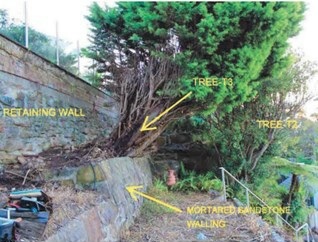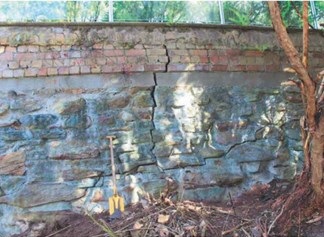Tree roots grow unseen below the ground. But the damage they do is visible. They lift paving and concrete driveways. They crack retaining walls, house walls and garages. They block sewer pipes.
This article examines who is responsible for the damage caused by tree roots, when removal of the tree roots or trees is justified, and compensation for damage caused.
The Law
The common law rights of a next-door neighbour to ‘sever roots which have spread from a neighbour’s trees onto his own land’ are the same as the right to prune overhanging branches and are subject to the same rules – see Tree Disputes - The right to remove overhanging branches.
The next-door neighbour has the right to sever roots to the boundary and install a root barrier or build a wall along the boundary to prevent root entry, at their own cost, so long as the tree is not compromised in terms of stability or health. This is known as ‘the abatement of a nuisance’. The entry of the tree roots into the land is the ‘nuisance’, the severing, the ‘abatement’.
But if the next-door neighbour desires to force their tree owner to remedy, restrain or prevent damage caused by tree roots or wants compensation for damage caused, they need a court order under the Trees (Disputes Between Neighbours) Act 2006 (NSW) (the Trees Act).
Part 2 of the Trees Act deals with trees that cause or are likely to cause damage or injury:
s 7
An owner of land [the applicant] may apply to the Court for an order to remedy, restrain or prevent damage to property on the land, or to prevent injury to another person, as a consequence of a tree to which this Act applies that is situated on adjoining land.
s 10(2)
The Court must … [be] satisfied that the tree concerned:
(a) has caused, is causing, or is likely in the near future to cause, damage to the applicant’s property, or
(b) is likely to cause injury to any person.
Notes:
‘tree’ is defined as ‘any woody perennial plant’ and includes bamboo, tiger grass/giant clumping grass and vines
‘near future’ is interpreted to mean ‘within the next 12 months or so’
A Council permit is not required if a Court orders the pruning or removal of tree roots
The Application is made to the Land and Environment Court of NSW
Case Studies
This is a selection of decisions in the Land and Environment Court of NSW:
Damage to a garage - Body v Bracks; Smith v Bracks [2021] NSWLEC 1614
Tree roots of a Mountain Grey Gum (Eucalyptus cypellocarpa) growing on Bracks’ land in Balmain in inner-city Sydney had uplifted the brick wall of Body’s garage causing a large crack and tilting, and possibly damage to the concrete garage floor. It was a large tree, approximately 15 metres high. The trunk was 1 metre away from the garage wall “and the collar was most likely growing against the wall’s footing below ground”.
The Court ordered the removal of the tree, despite its contribution to the landscape and public amenity, because it was “likely to cause further damage in the near future” and there was “no reasonably practical solution (such as pruning) to prevent the tree causing further damage other than removing it”.
The tree was to be removed to stump level (500 mm) by Bracks at her cost. Bracks was not required to remove the stump, or to remove roots from Body’s land. Body had to bear that cost. The Commissioner ordered that a replacement tree be planted in the yard - a native tree that will reach at least 6 metres in height at maturity.
The Commissioner refused compensation for the damage to the garage wall, because its condition had changed little since 2013, and so it was beyond the six-year limitation period for bringing a claim under the Limitation Act 1969 (NSW). As to the garage floor, there was no compensation because there was insufficient evidence to demonstrate that the concrete floor had not been damaged by other factors (such as subsidence).
Tree root-bound - Clarke v Goff [2021] NSWLEC 1672
A Jacaranda tree (Jacaranda mimosifolia) grew in the small front courtyard of an Erskineville property, in inner-city Sydney. The tree roots were causing damage - the boundary garden wall had been displaced and pavers had uplifted. Both neighbours wanted the tree to be removed, but the Sydney City Council refused the application for tree removal.
Acting Commissioner Galwey weighed up Council’s refusal which was based on the tree’s benefits, and the likely damage the tree roots would cause if it remained being insignificant:
The benefits were: “The tree contributes to the overall canopy cover of the City of Sydney’s urban forest. It contributes ecosystem services including cooling, reducing water run-off, removing air pollutants, carbon sequestration and more. It has intrinsic value to public amenity, standing at the very front of the respondents’ property. These values are recognized in the City of Sydney Urban Forest Strategy (2013) and other policy documents, and were rightly considered by Council when determining the application for tree removal.”
But the finding that the tree roots were going to continue to cause damage because it was root-bound was decisive: “this tree has outgrown the limited space in which it was planted. It has reached a size that requires a large root system, in turn requiring significant soil volume that is not available [where it was growing]”.
The Commissioner ordered that the tree be removed and be replaced by a tree of a species that will reach a height of at least 6 metres and a crown spread of at least 4 metres at maturity, at the tree owner’s cost.
Retaining wall damaged - Liu v Jiang [2021] NSWLEC 1571
A Golden Monterey Cypress (Cupressus macrocarpa Aurea’) was growing in a retaining wall which formed the common boundary at the rear of properties in Castle Cove.
Acting Commissioner Galwey found that while the retaining wall was in poor condition because it was structurally inadequate for its purpose, the size and location of the large crack near the tree were ‘a result of some force from tree root growth beneath the wall’. See photos:
 PHOTO 13 Tree-T3 - looking west
PHOTO 13 Tree-T3 - looking west
 PHOTO 19 Retaining wall cracks - opposite Tree-T3
PHOTO 19 Retaining wall cracks - opposite Tree-T3
The Commissioner ordered the removal of the tree for these reasons: the tree roots were likely to cause further damage in the future, the wall provided support for the Applicant’s land and swimming pool, pruning would not be appropriate and the tree provided limited amenity.
The Commissioner exercising jurisdiction under the Dividing Fences Act 1991 (NSW) (because a tree caused damage), found that the retaining wall’s design and construction were not adequate for purpose: the tree had “made a minor contribution to the wall’s condition, but its principal causes include loads placed on the wall by the Applicant’s raised land, and a lack of drainage on the Applicant’s land behind the wall”.
The Court ordered the retaining wall to be rebuilt, and apportioned the cost as to 90% to the Applicant (Liu) because they benefitted from the retaining wall and 10% to the Respondent (Jiang) because they had left the tree to continue to grow for some time. The cost of the work was estimated at $150,000.
Tree roots cut - Braun v Basser [2021] NSWLEC 1510
A tall slender form of a Cook Pine (Araucaria columnaris) stood deep in the back garden of a long narrow property belonging to Basser at Vaucluse. It could be seen from the surrounding landscape and contributed to the local landscape character, to public amenity, and to the landscape value of Basser’s property. It was a healthy tree 20–25 metres tall with a stem diameter of 700 mm.
Braun engaged a plumber to clear his sewer pipe near the boundary trap. It was an old earthenware pipe. The plumber reported that the sewer pipe was damaged by tree roots. Braun authorised its replacement with a new PVC boundary trap shaft. The plumber severed three structural roots (one 120mm, one 150mm and one 180mm) and cut 90% of the main tension root of the tree (200 mm) while installing the shaft. All of the root severance took place within 500mm of the tree, well within the SRZ [Structural Root Zone].
Braun engaged an arborist who recommended removal of the tree. Basser applied to the Council for removal, but the Council refused consent. Braun applied to the Court for orders for removal and compensation of $5,000 for damage to the sewer pipe.
Acting Commissioner Galwey said: “Considering these factors – the tree’s exposure to winds, its age, the recent loss of structural roots – I find it is likely that the tree might fail in the near future” and , “the tree must be removed because the likelihood of tree failure has increased following the is now likely to cause damage to Braun’s property or is likely to cause injury”.
The Court ordered Braun pay 75% of the cost of removal and Basser pay 25%, instead of the usual order that the tree owner (in this case Basser) pay 100% of the cost because Braun’s plumber’s actions in cutting the roots instead of installing a new section of pipe diverted around the roots, had resulted in the need for removal. He rejected the claim for compensation because there was no proof that the tree roots from the tree had damaged the sewer pipe.
Tree Roots uplifting and cracking house Pearson v The Owners Strata Plan No 12969 [2017] NSWLEC 1110
A Tallowood (tree to the right) and a Sydney Blue Gum (tree in the middle) were planted in the early 1980s less than 1 metre from the boundary. See photo.
Woody tree roots had grown under the brick footings of the 1910 era house (on the left) in inner city Enmore. The tree roots had expanded and caused “hogging” i.e. an upward deflection of the brick wall, and internal wall cracking. The tree owner argued that the cracking was caused by expansion and contraction of the reactive clay soil on which the house was built, and not the tree roots.
Orders: Both trees were to be removed, the stumps and woody roots ground. The tree owner was to pay the cost (about $15,000 per tree). The tree owner was also to contribute 20% to the cost of repairs to the sewer pipe, paving, etc.
Comments: The trees were growing too close to the house. The roots were lifting and twisting the foundations. The court would have preferred these indigenous trees to remain, but the arborists and engineers considered that cutting the roots to install a root barrier would destabilise the trees. Other trees nearby would ameliorate the visual amenity of these trees.

Mature Tallowood (grooved bark) and Sydney Blue Gum (white bark) growing 2 metres from neighbour's house. Removed by Court order
Image © Anthony J Cordato 2017
This article is the third in a series of five. The other articles are:
Tree Disputes - The right to remove overhanging branches
Tree Disputes - Tree branches and trunks causing damage
Tree Disputes - Trees causing injury
Tree Disputes - High hedges blocking sunlight or a view
Click to access them.
